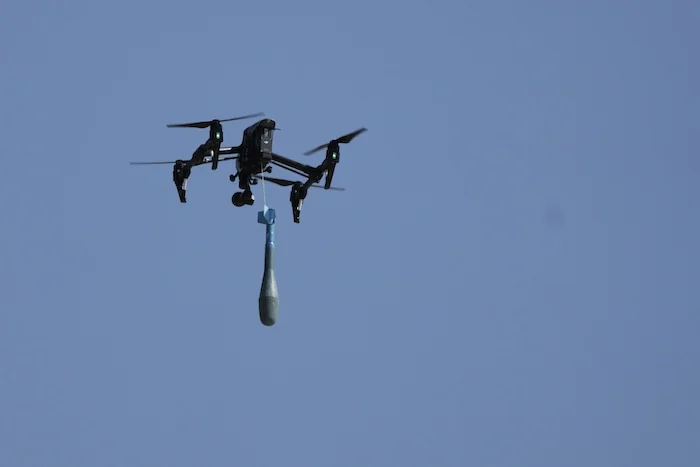Ukraine‘s surprise drone attack targeting dozens of Russian aircraft last week was a wake-up call for the Defense and Homeland Security departments to the emerging threats that unmanned aerial vehicles can pose domestically.
The mission, dubbed Operation Spider’s Web, involved the use of cheap drones to target much more expensive Russian aircraft deep behind enemy lines, which were used to carry out repeated bombings of Ukraine’s infrastructure.
In the daring operation, Ukraine smuggled more than 100 relatively cheap drones across the Russian border. They were then deployed with explosives, targeting Russia’s nuclear bomber fleet at multiple military bases. One hundred seventeen drones were involved in the mission that destroyed or likely inflicted billions of dollars in damages on roughly 40 Russian aircraft, about a third of the country’s fleet.
“The success of Ukraine’s coordinated drone strike against Russia’s long-range Air Force capabilities should serve as an indicator of future military operations,” Sen. Roger Wicker (R-MS), chairman of the Senate Armed Services Committee, told the Washington Examiner. “The operation is a reminder of our need to invest in drone technology and counter-drone technology to defend ourselves against similar actions from our adversaries.”
President Donald Trump, who is trying to broker a ceasefire between Russia and Ukraine, said on Wednesday after his call with Russian President Vladimir Putin that Putin is not ready for peace and is preparing to retaliate.
The specifics of the operation demonstrate the ingenuity involved. The Ukrainians smuggled drones into Russia, secretly placed them on trucks, and had Russian drivers unknowingly bring the trucks near the intended targets. Given that the drones were near the military bases the Ukrainians intended to target, Russia’s air defense capabilities were rendered largely ineffective in intercepting them.
“Reports indicate a coordinated strike against Russia’s strategic bomber force using a swarm of over a hundred inexpensive drones at a cost of a mere tens of thousands of dollars, Ukraine inflicted billions in damage, potentially setting back Russia’s bomber capabilities,” Army Secretary Dan Driscoll told lawmakers on Wednesday.
Last weekend’s successful operation was not Ukraine’s first irregular warfare mission in Russia, but it further demonstrated how cheap technology, often made with commercially available components, can be weaponized against some of the most advanced and expensive systems.
Russia and Ukraine have relied on drones heavily during their conflict, which has gone on for more than three years. A Ukrainian leader said earlier this year that drones have accounted for about 70% of all Russian and Ukrainian casualties.
The success of Ukraine’s operation raised questions about the United States’s vulnerability to a similar attack.
“I would say it’s a wake-up moment now, we’ve been awake, it’s just sort of an eyebrow-raising moment,” Gen. David Allvin, Air Force chief of staff, said during an event at the Center for a New American Security on Tuesday. “We’ve always known that hardening our bases is something that we need to do, and so we have that actually in our budgets, to be able to get more resilient basing.”
“This shows us that seemingly impenetrable locations maybe are not,” he added. “We need to pay more attention to that.”
Wicker acknowledged on Wednesday during an event with the Defense Writers Group that the U.S. military has a “myriad of aircraft all around the country” that would not be protected from an attack such as the one Ukrainians launched.
“There’s no doubt that we have a myriad of aircraft all around the country and all around the world that are stored in facilities, really, that are designed to protect them from the weather and are not resistant to explosives like the ones Ukrainians used,” he added. “It should be a wake-up call to the public. I’m not sure that it is much of a surprise to our military strategists and tacticians.”

As Wicker acknowledged, this is not a new threat. Drones have been tracked flying over U.S. military installations in the country.
There were roughly 350 drone incursions at more than 100 U.S. military installations in the past year alone, according to NORAD and Northern Command Chief Gen. Gregory Guillot. Some of those incidents were among the high-profile drone sightings last year.
Additionally, there have been national security concerns related to Chinese entities purchasing land near U.S. military sites in the country.
Given the concerns about collateral damage, it’s difficult to intercept a drone operating in the U.S..
None of those incidents amounted to intentional attacks, but U.S. bases in the Middle East have frequently come under attack over the last two years.
U.S. troops in Iraq, Syria, and Jordan were subjected to more than 100 drone, rocket, and missile attacks from Iranian-supported militias in the aftermath of the Oct. 7, 2023, Hamas attack and subsequent war in Gaza.
In January 2024, three U.S. service members were killed in a drone attack on Tower 22, a small U.S. base in northeast Jordan near its borders with Iraq and Syria. More than 40 service members were also wounded in the attack.
“It’s going to be a broad base of things that we need to do,” Gen. Randy George, Army chief of staff, told lawmakers. “How we’re going to do that in a combat zone is very different than how we would do that in the States. Obviously, doing that in the States, and we’re working, obviously, with NORTHCOM, you’re talking about FAA … with everything else that’s going on, so we’re continually working through that.”
Officials have noted there’s no silver bullet or magical solution to defending against drone attacks, especially with the proliferation of the technology.
President Donald Trump has championed his Golden Dome, a multifaceted air defense system to defend the homeland from space, ground, and sea-based missiles. He has said it will cost $175 billion to build and will be operational before he’s out of office.
While the details of the Golden Dome are still being hammered out, Bryan Clark, a senior fellow at the Hudson Institute, said the system will be designed primarily to intercept long-range hypersonic and ballistic missiles fired from elsewhere targeting the U.S.
“Based on the idea that it’s managed by the Space Force, [the Golden Dome] will be relying mostly on space based sensors and maybe space based interceptors suggests that Golden Dome is really designed mostly to address the ballistic and long range hypersonic threat — being missiles that are coming from outside the country that maybe spend part of their time in space, and therefore can be shot down while they’re in space,” he told the Washington Examiner.
OPERATION SPIDER’S WEB SHOWS HOW CREATIVE UKRAINE CAN GET IN TAKING FIGHT TO RUSSIA
Congress is working to allocate $25 billion for the initial expenses involved in producing the Golden Dome through the One Big Beautiful Bill Act, which is meant to enact much of Trump’s domestic agenda, though it only includes $3 billion for offensive drones and counter-drone technology.
“We do have $2 billion in the bill for drones and $1 billion for counter-drone technology,” Wicker added. “That’s a relatively small amount in terms of a percentage, but it is $3 billion. The public, at least now, is aware, and the public around the world, in our allied countries and in countries that wish us ill, that this is a vulnerability.”























